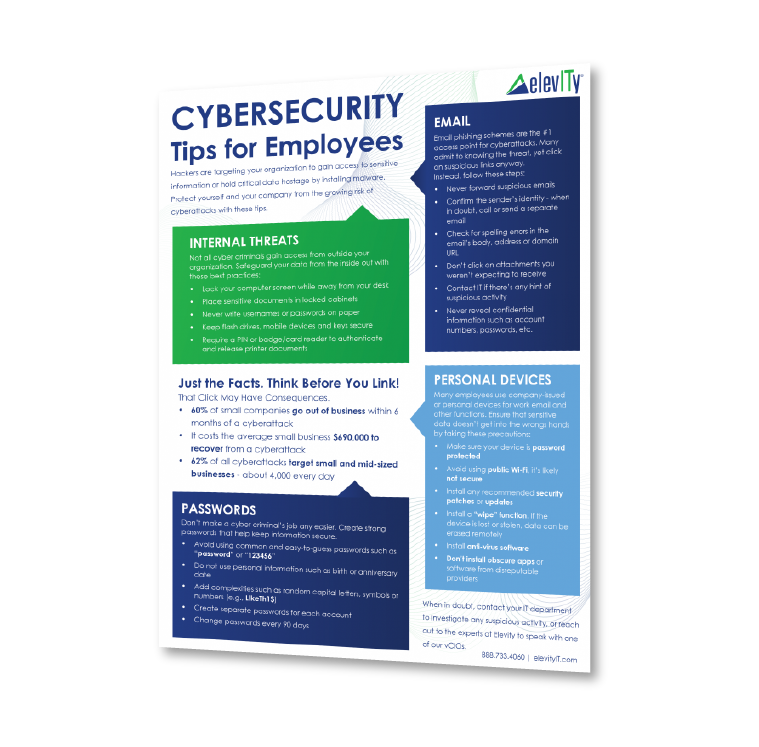Earlier this year, the nation was warned about the biggest cybersecurity threats for 2023. The top five threats:
- Remote workforce security
- Phishing and social engineering
- Ransomware
- Cloud security
- Internet of Things (IoT) security
Unfortunately, these are not uncommon risks for businesses and individuals alike. In such a connected world — and with remote work becoming more prevalent in the post-pandemic era — society is more vulnerable to the actions of cybercriminals than it’s ever been.
Businesses today have hundreds of applications installed and connected to their networks that could be security risks. Some of these applications may not even be supported or used by the organization, but are quietly running in the background. That’s an easy backdoor for cybercriminals.
Even the hardware itself could be increasing your risk of a cyberattack. If your desktop computers, laptops and other devices are getting old, they’re less capable of running current cybersecurity applications.
Let’s take a closer look at the issues caused by outdated apps, operating systems and hardware — and how to close these security holes.
End-of-Life Operating Systems & Software
When an operating system (OS) comes to the end of its lifecycle, it means that no more updates will be issued by the vendor — including patches for critical security flaws. These "stale" or "dead" systems are potential liabilities and growing concerns for exploits. The safety net, the helping hand, the crucial system fixes — they’re all gone, and you’re on your own.
It’s said that damage from the infamous ransomware WannaCry attack of 2017, which affected thousands of National Health Service hospitals in the UK, could have been avoided with updated software.
What’s more, it’s estimated that 70% - 80% of the top 10 malware detected by a company could be avoided if their technology was updated correctly.
Like operating systems, certain software or applications see support sunsets after a certain time. Still, many people still work with Microsoft Office 2003 applications, for example, even though it reached end-of-support in April 2014.
Since Office is a productivity tool suite (Word, Excel, PowerPoint, Outlook), it may seem unrelated to overall system security. But it can still open vulnerabilities to your whole network.
Related: How Long Does it Take to Detect a Cyberattack?
The Security Threat of Mobile Apps
Mobile devices present an equally dangerous threat to a business environment. Mobile phone and tablet manufacturers such as Samsung, Sony, Google and HTC only provide support and security patching to a phone’s OS for so long.
A vulnerable phone could allow full access to everything that's on it, including personal and company emails, contact information and banking details. It’s even possible that phone calls could be recorded.
Outdated IT Hardware Concerns
Computers and other devices that are several years old aren’t always keeping up with the advances in technology. Older hardware lacks the processing power or storage to run modern software such as encryption, network monitoring, malware detection and so on.
Upgrading to more up-to-date desktop computers, laptops and other devices as needed can ensure they’re capable of giving you all the advantages of current cybersecurity measures.
Fixing IT Vulnerabilities on Computers & Mobile Devices
Fortunately, in addition to upgrades in hardware, there are tools to detect when users have outdated applications on their computers and mobile devices.
Device Management Software
Device management software is a type of management or security technology that enables IT to monitor, manage and secure corporate or personally owned mobile devices running across multiple operating systems. However, this typically requires the end user or IT department to manually install the management tool on each device. Once the software is installed, the devices can be secured to meet the business’s security policy.
Company Protocols
One of the best ways to ensure your business stays up to date is through consistent documentation and a solid set of maintenance and update processes everyone’s aware of. Centralized management tools, such as Microsoft's Configuration Manager and others that push software updates, are valuable assets.
Remote Monitoring and Management
Another important tool for IT professionals is remote monitoring and management, or RMM. Also called patch management, RMM monitors and manages virtual machines, laptops, desktops and servers with identical automated deployments. These tools connect to networked PCs, remote devices, mobile devices and backups to ensure licenses and security patches are current.
Be Vigilant with Updates
Even if you think you’re aware and protected while online, updating your software and devices is an essential element of security that must not be overlooked. Given how fast hackers and malware evolve, businesses that use outdated legacy technology increase their cybersecurity vulnerabilities since they have trouble detecting new threats.
Bottom line: The cost it takes to recover from a cyberattack caused by an unsupported OS is significantly larger than the cost of upgrading your systems or hardware and training your team.
Your Cybersecurity Risk
Where exactly does your business stand? We’ve developed a tool for you to check your cybersecurity preparedness for free. Just take a few minutes to answer some simple questions, and we’ll email you your score and potential next steps.
Click the link below to our Cybersecurity Risk Assessment and get started today.





%20cropped.jpg)




